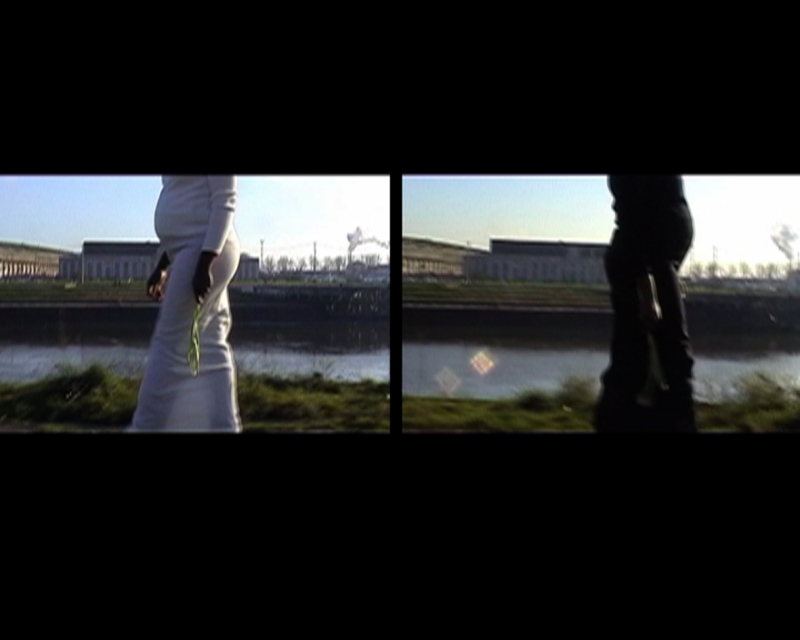Extrait (français) ///
L’œuvre artiste franco-congolaise Michèle Magema est multiforme puisqu’elle évolue aussi bien : Installations, vidéos, photographies, performances. Elle revisite l’Histoire noire de son propre point de vue : critique et pertinent. Par le biais de son expérience personnelle, elle nous offre de nouveaux angles de lectures d’une histoire depuis longtemps présentée de manière univoque. L’hybridité culturelle et la réflexion plastique sur le passé colonial sont au cœur de sa pratique plastique. Née en 1977 à Kinshasa (en République Démocratique du Congo), elle s’est installée en France en 1984 avec sa famille. Un exil politique expliqué par le refus de son père de se soumettre au pouvoir dictatorial de Mobutu Sese Seko (1930-1997) qui régnait d’une main de fer sur le Zaïre. La famille Magema quitte le pays pour vivre librement. Elle va ensuite étudier cinq années à l’Ecole Nationale Supérieure d’Arts de Cergy et obtient un diplôme d’expression plastique. Son travail est d’abord remarqué par les organisateurs de la biennale de Bamako, puis celle de Dakar, où elle présente Oyé Oyé (2002), une œuvre vidéo grâce à laquelle elle remporte le Prix du Président de la République Sénégalaise en 2004. Oyé Oyé est une confrontation entre deux écrans, le premier présentant en noir et blanc le chef Mobutu assistant, tel un roi, à un défilé officiel ; le second présentant en couleur l’artiste elle-même vêtue de l’uniforme scolaire obligatoire recréé d’après ses souvenirs d’enfance. En robe bleue traversée d’une bande blanche diagonale, l’artiste, dont le visage est volontairement occulté par un cadrage centré sur son corps, simule une marche militaire. En se moquant des obligations quotidiennes instaurées par la politique dictatoriale de celui qu’on appelait « Le Léopard de Kinshasa », l’artiste établit une critique de cette dernière. La marche militaire est tournée au ridicule, à l’image de la posture adoptée par Mobutu. Une critique de la dictature, mais aussi de l’utilisation du corps des femmes pour servir la propagande (lors de défilés, des danses officielles etc.). L’anonymat qu’elle conserve en cachant son visage indique qu’il peut s’agit de n’importe quelle femme de cette période. Le corps de l’artiste porte un message collectif, alors incarne alors le slogan féministe scandé à la fin des années 1960 : « personal is political ».
Trouvez la revue N PARADOXA – Africa and its Diasporas, ici : http://www.ktpress.co.uk/nparadoxa-volume-details.asp?volumeid=31
————————————————————
Abstract (English) ///
The work of the Franco-Congolese artist Michèle Magema comes in many forms since she develops installations, videos, photographs and performances equally happily. She revisits black history from her own critical and relevant point of view. Through her personal experience, she offers us new angles of interpretation for a history that has long been presented from a single perspective. Cultural hybridity and thinking about the colonial past in visual terms are central to her creative practice. Born in Kinshasa (in the Democratic Republic of Congo) in 1977, she settled in France with her family in 1984: political exile explained by her father’s refusal to submit to the dictatorial power of Mobutu Sese Seko (1930-1997) who ruled Zaïre with an iron fist. The Magema family left the country to lead a free life. She went on to study for five years at the Ecole Nationale Supérieure d’Arts in Cergy, and was awarded a degree in visual and performing arts. Her work attracted the attention first of the organizers of the Bamako biennial, then those of the Dakar biennial, where she showed Oyé Oyé (2002), a video work for which she was awarded the Prix du Président de la République Sénégalaise in 2004. Oyé Oyé is a confrontation between two screens, the first presenting the leader Mobutu in black and white presiding over an official parade, like a king, and the second presenting the artist herself in colour, dressed in the compulsory school uniform which she recreated based on her childhood memories. In a blue dress with a diagonal white band acrossit, the artist whose faceis deliberately obscured by a framing centred on her body simulates a military march. By making fun of the daily obligationsintroduced by the dictatorial policy of the man known as “The Leopard of Kinshasa”, the artist establishes a criticism of that policy. The military marchis made ridiculous, asis the posture adopted by Mobutu. A criticism of dictatorships, but also of the use of the female body for propaganda purposes (at parades, official dances, etc.). The anonymity she preserves by hiding her faceindicates thatit could be any woman of that period. The artist’s body carries a collective message, embodying the feminist slogan chanted at the end of the 1960s: “personalis political”.
Find N PARADOXA ————> Africa and its Diasporas here : http://www.ktpress.co.uk/nparadoxa-volume-details.asp?volumeid=31
n.paradoxa
international feminist art journal
volume 31, Jan 2013 (Africa and its Diasporas)
‘Editorial’ pp. 4
‘African masks, family photographs and open suitcases: Rosana Paulino, Mónica de Miranda and Maimuna Adam’ pp. 5-14
‘Michele Magema: Without Echo, there is no Meeting’ pp. 15-22
‘Silent Toyi-Toyis in the work of Donna Kukama and Reshma Chhiba’ pp. 23-31
‘Artists Pages: Ayana Jackson, Zanele Muholi, Pinar Yolacan, Angele Etoundi Essamba’ pp. 32-46
‘Contemporary women artists in Tunisia: Meriem Bouderbala, Mouna Jmal, Sana Tamzini, Fatma Charfi’ pp. 47-52
‘Taiye Idahor, Ato Malinda, Adwoa Amoah, Maimuna Adam, Mary Sibande’ pp. 53-57
‘Cut to the Chase: The Work of Mary Evans’ pp. 58-64Cheryl Thompson
‘Contesting the Aunt Jemima Trademark through Feminist Art: Why is She Still Smiling?’ pp. 65-72
Solange Farkas
‘From “ferramentaria” to trance: Symbolism, concept and religiosity in the work of Eneida Sanches’ pp. 73-77
Peju Layiwola
‘From Footnote to Main Text: Re/Framing Women Artists from Nigeria’ pp. 78-87
Zehra Jumabhoy
‘Betwixt and In-Between: Reading Zarina Bhimji’ pp. 88-95


